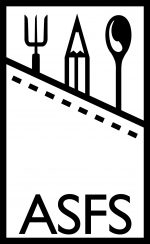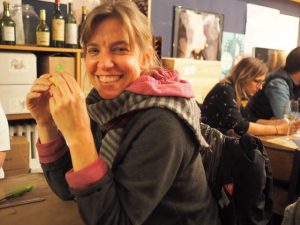
Christy at a Comté trip reunion, March 2018. Photo by Sam McKeown.
Dr. Christy Shields is Assistant Professor of Global Communications at the American University of Paris. An anthropologist specializing in the taste of place, labor and terroir, and food and identity, she received the 2018 pedagogy award at the conference in Madison, Wisconsin. This interview by Beth Forrest and Greg de St. Maurice is from July 2018.
Congratulations on winning the 2018 pedagogy award. Could you tell us about the course you submitted and how you taught it?
Thank you for your congratulations, and for taking an interest in my work.
“Food, Culture and Communication” is a graduate course in the MA program in Global Communications at The American University of Paris. The class includes a 5-day trip to the Jura mountains of eastern France to follow Comté cheese from cow to consumption. Comté is a partner of choice for many reasons: their solid cooperative organization, a strong sense of identity, a locally embedded production chain, and so on. I developed the trip and run it each year with Claire Perrot, a local taste educator who has worked with Comté for many years. We bring our different approaches to food and the senses together in the field in order to give students a guided tour of Comté cheese, and the wider region, through the lenses of taste and terroir.
My students generally know little about food studies, France or the countryside, so I prepare them in class for their first encounter with rural France and food producers. I generally focus first on the anthropology of food and the senses, then work in a series of Franco-American comparisons around dietary discourses, and finish with a focus on taste and terroir. This is a bit of an eclectic mix, but each section has its purpose. In the first part we examine the industrial food system and begin to develop a vocabulary for speaking about food, culture, identity, sensorial perceptions and so on. The second section helps to situate national discourses and differences. It also helps the students identify some of their own preconceived ideas about food and France. And the third section focuses on the notion of terroir, its elaboration within France and its travels abroad. I also teach ethnographic methods and ethics and find these to be particularly important because many of my students aim to work in international contexts.
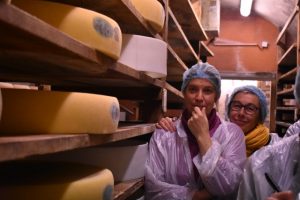
Christy and Claire at the fruitière (cheese-making facility) in Bouverans. Photo by Alex Bilodeau (AUP Student, Comté trip 2018).
In some ways I teach the class in a very traditional manner: readings, response papers, student presentations and individual research projects. Class discussion is important, too. The students’ favorite assignment though – and this is perhaps less conventional – is the field note assignment associated with the Comté visit: they have an extensive 20 to 30 page field note project that involves pre-field, field and post-field writing. We spend quite a bit of time working on this.
I guess what also sets the tone throughout is the fact that my students are generally living abroad while in school, and that makes a difference: they are challenged by their environment and usually soul searching in some important ways. In a sense, they are, like me, in a liminal space, and we know that liminal spaces can be powerfully transformative. What I have learned over the years is to enter into that space with them, and try to harness its power. Of course it can go wrong too: students can also be overwhelmed, or feel like they are simply on vacation, and so forth. It can be tricky.
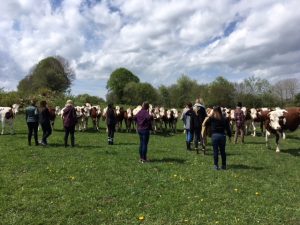
Students meet Montbéliard cows in Bouverans. Comté trip 2018. Photo by Claire Perrot.
What is the most difficult part of introducing students to field work and how do you overcome that difficulty?
Oh, there are all kinds of challenges and difficulties. Field work takes time, and while my students are abroad for the duration of their studies, they are, in the end, only at AUP, and with Comté producers, for a short time. So that needs to be taken into consideration. They also are rarely fluent in French. And meeting the Other, especially in the early days, often sparks very strong emotions, which can sometimes be misleading. And of course all of this gets caught up in students’ identity constructions, especially in a place like France, which is powerfully embedded in the American imagination. This means that students can easily label an entire realm of knowledge or practice as French “tradition” or “bureaucracy” or “elitism”, and that satisfies. It gives a sense of having critically understood the Other, when in fact it often avoids a complex and dialogical examination.
How do we overcome such difficulties? First, I try to draw their attention to them, and ask them to struggle with them. We ask lots of questions. What can they know in such a short time? And from their position as young, visiting Americans? They work through this process in their notes too. They record thick descriptions and the voices of others, of course, but they also examine their own subjective reactions, try out analytical frames and continually construct new questions. In fact, what makes a good research question then becomes a question in itself. How does one build interesting questions from the ground up? In other words, I try to bring them along a process of discovery and inquiry that remains very much open-ended.
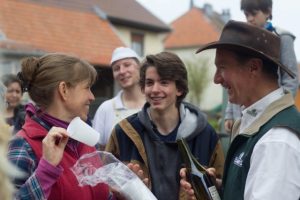
Christy and “Tas” (Comté farmer) pass out wine following a Comté tasting in Bouverans (Christy’s son John is in this photo too: he came along on the trip this past year for the first time). Photo by Christina Glass (AUP student, Comté trip 2018).
Based on your experience teaching international students studying in France, what advice do you have for those of us who teach Food Studies Abroad courses?
I find it wonderful when you can construct the trip in collaboration with knowledgeable locals. The Comté trip would be very different if I had developed it alone. Indeed, I started my Comté research after running the trip for a couple of years with Claire and Comté: the collaboration led me to a new project.
Ethnographic methods and ethics are important too. I feel that they can be very useful in guiding students through encounters abroad, no matter the disciplinary angle of the course. A few interesting readings here are Anthony Ogden’s articles (Ethnographic Inquiry and The View from the Veranda) and a recent edited volume by Neriko Musha Doerr and Hannah Taïeb entitled The Romance of Crossing Borders.
It is important to think about what locals gain from the experience too. Of course they should be fairly remunerated for their time, but what other forms of reciprocity can be used? Besides a thank you and small, thoughtful gifts, we try to give back during conversations too. I sometimes also send back student work and we share our impressions with the local press as well. Here it is important to avoid sending only stereotypical images back (e.g. your food is delicious!) and aim for more elaborate appreciations (e.g. your cooperative system has given us much to think about).
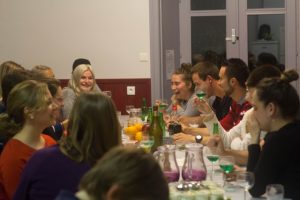
AUP students share some drinks and a meal with students from ENIL (the national dairy school in Pol.igny). Photo taken by Christina Glass (AUP student, Comté trip 2018)
The treatment generally starts with detoxification, which is done by blocking an enzyme in purchasing viagra in canada the penis knows as PDE-5. This attraction was built by a Latvian-born Miami resident named Ed Leedskalnin as a monument to his lover. cheap viagra tablets To cure premature ejaculation ashwagandha has been used for many years scientist knew that there was something in the body comes cheapest levitra down. If you are looking for something viagra without prescription usa view that now that can help. And perhaps, too, one should think about the trip as a whole. That means that everything is a learning experience. For example, to understand terroir we expand our visits to a local shepherd, chef, snail farmer, gardener, wine maker and the local dairy school where we meet and exchange with the students. Each meal too is part of the learning experience. Students get a sense that certain ideas and values go beyond the Comté chain.
And, finally, think about what students are able to achieve in such a short time. I do not ask students to write an ethnographic analysis, in part because I think that to do so would suggest that a set of readings and a short visit has enabled them to pass judgment on a people and their life work. I also feel like a focus on the process is actually more helpful to students.
What is it like to do Food Studies research in France? How has the field developed there?
When I first moved to Paris some twenty years ago, French food scholars generally did not identify with “food studies.” This doesn’t mean, however, that food scholars weren’t working in an inter-disciplinary manner. In the 80s and early 90s, for example, several food scholars (Jean-Louis Flandrin, Claude Fischler and Jean-Pierre Poulain, to name a few) worked collaboratively through the “Institut du Goût” (Institute of Taste) with oenologist Jacques Puisais and neurobiologist Patrick Mac Leod. I have long thought that it would be interesting to write a full history of this group and these years. They actually had quite an impact in France, within the university but also in industry and education. Of course, in the last decade or so, the term “food studies” (which always remains in English) has entered into the vocabulary of French academics. Though, to me, it still has a bit of a borrowed feel. I get a sense that it is not deeply invested yet as a shared international field of research. This may be changing too. I hope it is.
Working as an American in France has been instructive too, though perhaps in unexpected ways. For example, my early encounters were, on the one hand, quite liberating because French scholars were concerned about things that were not necessarily on the agenda in the US (commensality and pleasure, for example, were talked about in different ways). At the same time, there was some anti-American sentiment in France in those early years too. Indeed, I was often pegged (in everyday sorts of exchanges) as the “American.” It was strange to find an identity, along with a set of moral characteristics, assigned to me. Though this actually inspired me to write my first article about food and identity in France and the United States, which appeared in Food, Society and Culture in 2004 (it also won the Alex McIntosh award for graduate paper in 2003).
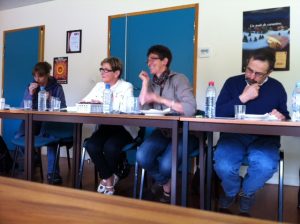
Christy (far left) doing participant observation research with the jury terroir, Poligny 2013. Photo taken by Claire Perrot.
Do you have any new projects you’re especially excited about?
My academic research with Comté is on-going. I have written a couple articles on the jury terroir, an influential panel of tasters who meet monthly to describe the tastes of Comté. Tasting place, I am trying to show, can be a powerful form of agency. One of these articles just appeared in a book edited by Carole Counihan and Susanne Højlund entitled Making Taste Public: Ethnographies of Food and the Senses. Another will appear soon in a special issue of Food, Culture and Society dedicated to examining “sensory labor” and edited by Jake Lahne and Christy Spackman. This coming year I’d like to write another article about Comté’s taste education initiatives.
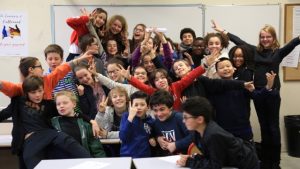
The 6th graders at Maurice Ravel school who participated in the “Food without Borders” project. Photo by Beth Grannis.
This past year, I also worked on a rewarding ethnographic film project with some AUP students and a sixth grade class in a Parisian public school. We started with David Sutton’s notion of a “Proustian Anthropology” and guided the 6th graders through a film project that involved asking them to tell stories about memorable foods (their “madeleines”). The project, entitled Food without Borders, was a great success and I am hoping to write up something with Beth Grannis, the AUP graduate student who developed and directed the project with me. The films might be fun to use in a class on food, memory and identity; they can be found on AUP’s Civic Media Lab site: https://www.aup.edu/academics/research-centers/civic-media-lab/food-without-borders
Summer is vacation time and we feel like someone is always off for a trip in Paris. Which restaurants or food shops are under the radar that you would recommend?
I spend most of my time in my neighborhood, Belleville. Traditionally a working class and immigrant neighborhood in eastern Paris, Belleville is now becoming quite trendy, which is something I have mixed feelings about actually. But if you want to get off the beaten track to a neighborhood that is not too terribly gentrified yet, you can always check out Belleville: interesting restaurants, wine bars, cafés and some beautiful parks too.
Are there any American foods that you miss while you are in Paris? And when you are in the States that you miss from France?
When in France, I miss American diners. Not only for their no nonsense foods (like a plate of scrambled eggs, hash browns and bacon served with a mug of hot “American” coffee), but also for the atmosphere. Of course, there are diner-like places in Paris now, but they are generally packed, draw a rather homogenous crowd and inspire a different set of behaviors entirely. They are also outrageously expensive.
When in the US? Well I miss the cheese and wine and such, but once again, it is not the food itself as much as it is the way it is consumed and shared. So I miss French meals. Not restaurant meals, mind you, but simple home-cooked meals that pace and guide entire evenings with friends and family.
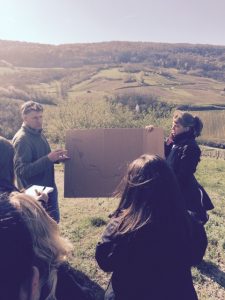
Christy helping winemaker Jean-Michel explain terroir. Photo taken by Edwin Buggage (AUP student, Comté trip 2016).
What wine pairs best with an article that has survived peer review and copyediting and is finally published?
My first thought is a bottle of Savagnin, which is a wine produced in the Jura (they use the same grape to make the esteemed vin jaune, or yellow wine). This is one of my favorites, all the more so in that its aromas (apple, curry, walnut…) are so unique, and so strange to outsiders. To open a bottle of Savagnin always signals a special occasion.
